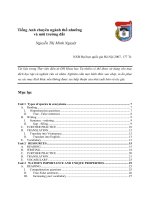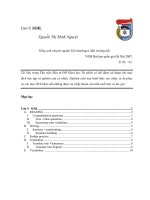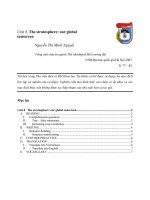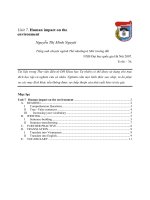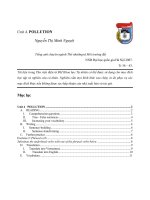Tiếng anh chuên ngành thổ nhưỡng và môi trường đất ( unit 15 )
Bạn đang xem bản rút gọn của tài liệu. Xem và tải ngay bản đầy đủ của tài liệu tại đây (204.02 KB, 14 trang )
Tiếng anh chuyên ngành Thổ nhưỡngvà Môi trường đất
NXB Đại học quốc gia Hà Nội 2007.
Tr 142 – 154.
Tài liệu trong Thư viện điện tử ĐH Khoa học Tự nhiên có thể được sử dụng cho mục
đích học tập và nghiên cứu cá nhân. Nghiêm cấm mọi hình thức sao chép, in ấn phục
vụ các mục đích khác nếu không được sự chấp thuận của nhà xuất bản và tác giả.
Mục lục
Unit 15 Human impact on soils 2
A. Reading 2
I. Comprehension questions 3
II. True-False sentences 4
I. Comprehension questions 6
II. True-False sentences 8
III. Increasing your vocabulary 8
B. WRITING 9
I. Sentence-building 9
II. Sentence - transforming 10
C. FURTHER PRACTICE 11
Gap-filling 11
D. TRANSLATION 12
I. Translate into Vietnamese 12
II. Translate into English 12
E. Vocabulary 13
Unit 15. HUMAN IMPACT ON SOILS
Nguyễn Thị Minh Nguyệt
Unit 15
HUMAN IMPACT ON SOILS
A. Reading
•
Warm-up Activities
- What are the good and the bad effects of human activities on soils?
part I
Soil is a great natural resource. It is a combination of mineral and organic matter,
structurally arranged in layers, and capable of supporting plant and animal life. Soils cannot
exist without plants, and plants are dependent on soils for support, air, water, and nutrients.
Soils are highly variable in nature. This variation includes their structure, layering, color,
range of particle sizes, chemistry, nutrients, acidity, temperature, water content, thickness,
organic content, and its associated biota. These properties vary because of differences in the
parent material, climate, topography, organic content, and the amount of time it has had to
develop. Changes in one or more of these factors may drastically alter the soil properties,
changing its nature and ability to support particular plant species. These changes can happen
very easily, having profound effects on the soil and the landscape such as vegetation
reduction, soil erosion, slope instability, increased flooding, and more sediment in rivers. The
major changes induced by human activities include chemical changes (salinization and
laterization), structural changes (compaction), hydrological changes, and soil erosion.
There are many chemical changes within a soil which can be initiated by humans. The
most widespread and problematic are salinization and laterization.
Salinization involves the accumulation of salts such as sodium chloride, potassium
chloride, calcium sulphate, and sodium carbonate within a soil. This makes the soil alkaline,
caustic, and generally restricts or inhibits plant growth. Salinization may also lead to
secondary problems such as soil erosion resulting from poor plant growth. Salinization may
occur naturally in semi-arid and arid areas where evapotranspiration or direct evaporation
from the soil exceeds precipitation. It may also occur in coastal regions which have saline
groundwater.
In areas where the evaporation of water from the soil is high, water is drawn upwards and
evaporated from the soil surface. Hence salts are left behind and are concentrated near the
surface of the soil. These results in a hard salty layer within the soil called a salt pan.
Salinization can be induced by irrigation and water abstraction.
The abstraction of water leads to a rise in the groundwater table, driving salts towards the
surface. In coastal regions, withdrawal of underground freshwater, which floats on top of
underground saline water (originating from the sea), pulls the saline water beneath it nearer to
the ground surface, contaminating the fresh water in the soil. In addition, water in wells may
become saline and therefore useless. This is a particularly big problem in coastal regions such
as California and Israel, and islands such as Bahrain and Long Island, New York. This was
also a problem in cities such as London and Liverpool during the middle of the last century,
until effective management of groundwater resources was introduced.
Irrigation also enhances salinization by increasing the height of the water table in the
immediate and adjacent areas over which irrigated water is spread. This leads to the
evaporation of water from within the soil, providing a process by which soil salts can be
concentrated and drawn towards the ground surface. With the rapid expansion of irrigation
schemes in the last 20 years, the UN estimates that as much as 25 per cent of irrigated areas
have become affected by salinization, making it a major land management problem. For
example, the percentage of soils affected and water logged amounts to 50 per cent of the
irrigation areas in Iraq, 23 per cent in Pakistan, 30 per cent in Egypt, and 15 per cent in Iran.
(Taken from "Environment Soil Biology" by Martin, W)
I. Comprehension questions
Answer the following questions
1. What is the two-sided dependence of soil and plants?
2. What does the variation of soil consist of?
3. What make the soil properties change? How do these changes occur?
4. Give examples of these changes' effects on soil and landscape.
5. What are the most widespread and problematic chemical changes?
6. What does salinization involve? What makes the soil alkaline, caustic, and generally
restricts or inhibits plants growth?
7. Where does salinization take place?
8. Where are salt left behind and concentrated near surface of the soil?
9. When there are a lot of salts in a soil layer, what do you call this phenomenon?
10. What is the big problem in coastal regions?
11. How does irrigation enhance salinization?
12. What does the UN estimate?
II. True-False sentences
Decide whether the following statements are true "T", false "F" or there’s no
information "N" according to the text. Correct the false statements.
1. There's an interaction between soil and plants.
2. Changes to a soil structure can also have a profound effect on its properties.
3. Because of having differences in the parent material, climate, topography,
organic content, and the amount of time it has had to develop, the soil properties
change.
4. Alteration in topography can not make the soil properties alter.
5. Vegetation reduction and soil erosion are the most serious effects of changes of
soil properties on the soil.
6. Human beings cause many chemical changes.
7. Salinization takes place in coastal areas only.
8. Salinization prevent plants from growing.
9. The great impact on soil is caused by soil erosion.
10. The soil in coastal areas with high evaporation of water from the soil is very
salty.
11. In coastal regions, fresh water is not polluted and wells are not salty.
12. London is the only city in the world suffering water problem for the last
decades.
PART II
Laterization of the soil is a major problem in the tropics where soils are enriched in
aluminum and iron oxides. These metal oxides accumulate due to strong tropical weathering.
Minerals in rocks are decomposed releasing metal ions into the soil water. These are
transported and concentrated by seasonal wetting and drying of the soil as layers of metal
oxides. Problems start to occur when these lateritic layers become exposes to air. They
become hard and inhibit plant growth leading to soil erosion and its associated problems.
Exposure of these layers may also be due to soil erosion, often as a result of deforestation. In
addition, deforestation may lead to increased evaporation of water from the soil, enhancing
the process of laterization. The extent to which laterization is a problem has not been fully
assessed, but particular problem areas include northern India, the Cameroon, and central
Africa. Unfortunately, populations in these countries are heavily dependent on soil for
subsistence agriculture and often degradation is difficult to reduce due to increasing pressures
of population growth on those lands.
Changes to a soil structure - its mutual arrangement of grains - can also have a profound
effect on properties. These include the soil ability to retain water, to allow water to enter and
flow through it, the strength of the soil, the degree to which the plant can penetrate it as well
as the withdrawal of water from it, and it resistance to erosion. The main way soil structure
can be altered is through the compaction, the pushing together of soil grain. This may be done
by vehicles driving over its surface, overgrazing, trampling along public footpaths, or by
ploughing, which compress the soil immediately below the ploughed surface.
Compaction reduces the ability of a soil to retain water, to hold air, and to allow water to
enter the soil and it increases its hardness. This retards or inhibits plant growth and it may
enhance processes such as soil erosion by wind and water. Soil compaction is a worldwide
problem, but it is often greatest in developed countries where vehicles are common. Soils are
commonly ruined adjacent to building sites, and on old battlefields or military training areas
where heavy vehicles are particularly common. Unfortunately, compaction of soil is one of
the hardest soil problems to remedy and it may take many decades before a soil can regain its
original structure.
Human also alters the chemistry of soil by the addition of organic or artificial fertilizers.
This may help increase the agricultural productivity, but it may also be detrimental to the soil,
especially if the fertilizers are incorrectly applied. This may lead to the deterioration of the
soil, a reduction in vegetation, soil erosion and other associated phenomena.
By far the greatest impact on the soil is caused by soil erosion. This includes the abrasion
of water running over the surface, the breakup of soil due to the impact of raindrops, and the
deflation of soil particles by the wind. The various causal factors that may initiate soil erosion
have already been discussed, such as deforestation, grazing, salinization, laterization, and
compaction. Many of these factors are inter-linked and should not be considered in isolation.
Bad farming techniques, urbanization, construction, mining, wars, and fires may also
accelerate them. Some of the worst affected areas are the result of a combination of these.
These areas include many of the coastal regions of the Mediterranean Sea, where fires and
wars have led to vast areas of badlands. Particularly, problematic are the consequences of soil
erosion. These include the increased likelihood of flooding, increased sediment loads often
leading to silting up of reservoirs, and landsliding.
Much can be done to try to retard soil erosion and conserve soil resources. These include
re-vegetation, crop management, slope run-off control, construction of gabions, and retaining
walls and the dissemination of information regarding good land-use practices. There is still,
however, much to be achieved with regard to the correct use of one of the most valuable
natural resources.
(Taken from "Environment Soil Biology" by Martin,W.)
I. Comprehension questions
Answer the following questions
1. What is the main problem in the tropics? What are thesoils in the tropics enriched
in?
2. What do the decomposed minerals in rocks release into the soil water? What may
lead to increased evaporation of water from soils?
3. People in what countries depend on soil for substance agriculture heavily?
4. Why is it difficult to reduce soil degradation in these countries?
5. How do changes to a soil structure affect soil properties? What do these include?
6. What is soil compaction caused by? What effects does compaction have on soils?
7. How long does it take to regain soil original structure?
8. How do people change the chemistry of soils?
9. What are good and bad sides of the addition of organic and artificial fertilizers to
soils?
10. What are the causal factors initiating soil erosion?
11. What should we do to retard soil erosion and conserve soil resources?
12. In your opinion, what have we done wrong with our soil resources?
II. True-False sentences
Decide whether the following statements are true "T", false "F", or there’s no
information given "N" according to the text. Correct the false statements.
1. Soil erosion is the most serious impact on the soil.
2. If the fertilizers are used properly, agricultural productivity will be increased.
3. Neither organic fertilizers nor artificial fertilizers have bad effects on soils.
4. Careful monitoring and management of erosional and depositional processes
have to be undertaken to care for this environment.
5. Before minerals in rocks are decomposed, they emit metal ions into the soil
water.
6. When lateritic layers are exposed to air, they become hard and it is difficult to
grow plants on.
7. Soil erosion is one of the crucial problems in the world today.
8. Soil degradation in India, the Cameroon, and Central Africa is blamed on the
growth of human population.
9. In developed countries soil compaction is not a problem because of the number
of vehicles in these countries.
10. The pushing together of soil grains is called soil compaction.
11. Rapid degradation of the forest soil accompanies deforestation.
12. Compaction allows water to enter the soil and make the soil softer.
III. Increasing your vocabulary
Synonyms: Which words or phrases in part II have the same meaning as:
13. delay a progress
14. hasten
15. find access into
16. lying near
17. become worse
18. wearing away
19. link together
20. thrust out
B. WRITING
I. Sentence-building
Make necessary changes and additions to complete the following sentences from the
prompts given below.
1. It / be / clear / that / man / be / now / one / major factors / soil formation /
development.
2. Deforestation / the degradation / other vegetation, / particularly / near / margins /
deserts / have caused / vegetated land / become barren / in / process / called /
desertification.
3. Many scientists / argue / desertification / have not / occur / as / result / human /
activities.
4. Organic soils / develop / mostly / plants / have / fall / stagnant water / where
decomposition / be / slow.
5. Soil organic matter / be / a / very / active / important / portion / soil.
6. Organic materials / be / decompose / microorganisms / particularly / bacteria / fungi.
7. Today, human activity / may / play / role / soil / degradation / world.
II. Sentence - transforming
Change the following sentences from passive voice into active voice and vice versa.
8. Our effects on soils are highlighted by catastrophic events.
9. People have classified soils according to their texture.
10. Carbonates may be found in all the particles-size classes of soil.
11. Two of them are doing a research on soil formation.
12. Agricultural management causes seasonal changes particularly in the topsoil through
cultivation and fertilization.
13. This book deals with the measurement of soil properties.
14. The natural cycle has been broken down by the application of other materials to soil
which adds a new dimension to soil formation.
15. The great impact on soil is caused by soil erosion.
16. Human beings cause many chemical changes.
17. Unsustainable methods of farming cause erosion.
C. FURTHER PRACTICE
Gap-filling
Choose the correct word or phrase to fill in each gap in the following passage. Each
of them is used once only.
consists
enabling
except
ideal
involves
keeping
litter
necessary
normal
piles
preserve
provide for
spaces
where
which
without
Conservation is the protection and wise management of the environment. People practice
conservation so that the environment can (1) their needs and the needs of all
other living things. (2) conservation, all the resources (3) for
life-air, animals, energy, minerals, plant, soil, and water-would be damaged, wasted, or
destroyed.
Conservation also (4) a concern for the quality of the environment, so
that people can enjoy living. It means (5) the environment comfortable and
safe - and an interesting, stimulating place in (6) to live. A healthy
environment includes clean streets and high ways, with open (7) in
cities for parks and playgrounds. (8) surroundings means landscapes free for
junk and (9) They include wilderness regions (10) animals and
plants can be safe from destruction by human being.
(Taken from "Extra Practice" by George, D)
D. TRANSLATION
I. Translate into Vietnamese
The domestication of animals has a major impact on the soil surface. Heavy grazing of
cattle leads to trampling and compaction of the soil, reducing its capacity to hold water and
altering its structure. Ultimately this leads to soil erosion, both by wind and water. Selective
grazing of particular plants may lead to changes in the nature of the vegetation cover. In the
UK, for example, heavily grazed pastures in Scotland are dominated by bracken, a successful
plant which survives because it is particularly distasteful and prickly to sheep and cattle. The
growth of trees may be inhibited as grazers favor young saplings. Grazing, however, may
have positive effects on the land because the animals provide faeces, a natural fertilizer rich in
nitrates and other nutrients. Animals also help propagate seeds, and grazing may increase
species diversity by opening up new communities and creating new niches.
(Taken from "Environment Soil Biology" by Martin.UW.)
II. Translate into English
1. Việc tưới tiêu và canh tác thông qua sử dụng máy móc có thể dẫn tới sự ngập úng và
giảm chất hữu cơ trong đất.
2. Sự tích tụ chất hữu cơ dẫn đến sự phân biệt về tầng đất trong hầu hết các loại đất.
ảnh hưởng của chất hữu cơ đối với các quy trình của đất sẽ phụ thuộc không chỉ vào
lượng chất hữu cơ mà còn phụ thuộc vào mức độ phân hủy.
3. Các sinh vật trong đất đóng một vai trò trọng trong sự hình thành và phát triển của
đất.
4. Sự phát triển của đất có thể được xem như là kết quả cuối cùng của các quá trình
hình thành đất và sự xói mòn đất.
E. Vocabulary
1. abrasion (n) : sự bào mòn
2. accelerate (v) : hối thúc
3. accumulate (v) : tích tụ
4. adjacent (adj) : gần kề, lân cận
5. breakup (n) : sự phá vỡ
6. caustic (adj) : ăn mòn
7. compact (adj) : nén, chặt
8. compress (v) : nén, ép
9. contract (v) : co lại, rút lại
11. detriment (n) : thiệt hại
12. drain (v) : rút nước, thoát nước
13. expose (v) : phơi trần, để lộ
14. extrude (v) : phụt ra
15. hydrology (n) : thủy văn học
17. initiate (v) : bắt nguồn, xuất phát từ
18. instability (n) : không ổn định
19. inter-link (v) : kết nối
20. landslide (n) : lở đất
21. likelihood (n) : sự có thể
22. mutual (adj) : lẫn nhau
23. penetrate (v) : thâm nhập, thấm
24. precipitate (v) : thúc đẩy, đẩy nhanh
25. precipitation (n) : lượng mưa
26. property (n) : đặc tính
27. regain (v) : thu lại
28. remedy (n) : chữa trị, biện pháp phòng ngừa
29. retain (v) : giữ lại
30. retard (v) : làm chậm lại
31. saline (adj) : có muối, mặn
33. slop (n) : nước thải
34. slope (n) : chỗ dốc, nghiêng
35. subside (v) : lún
36. subsidence (n) : sự lún xuống
37, topography (n) : địa hình học
38, trampling (v) : giẫm đạp
39. transpire (v) : tiết ra, thoát ra
40. undesirable (adj) : không mong muốn
